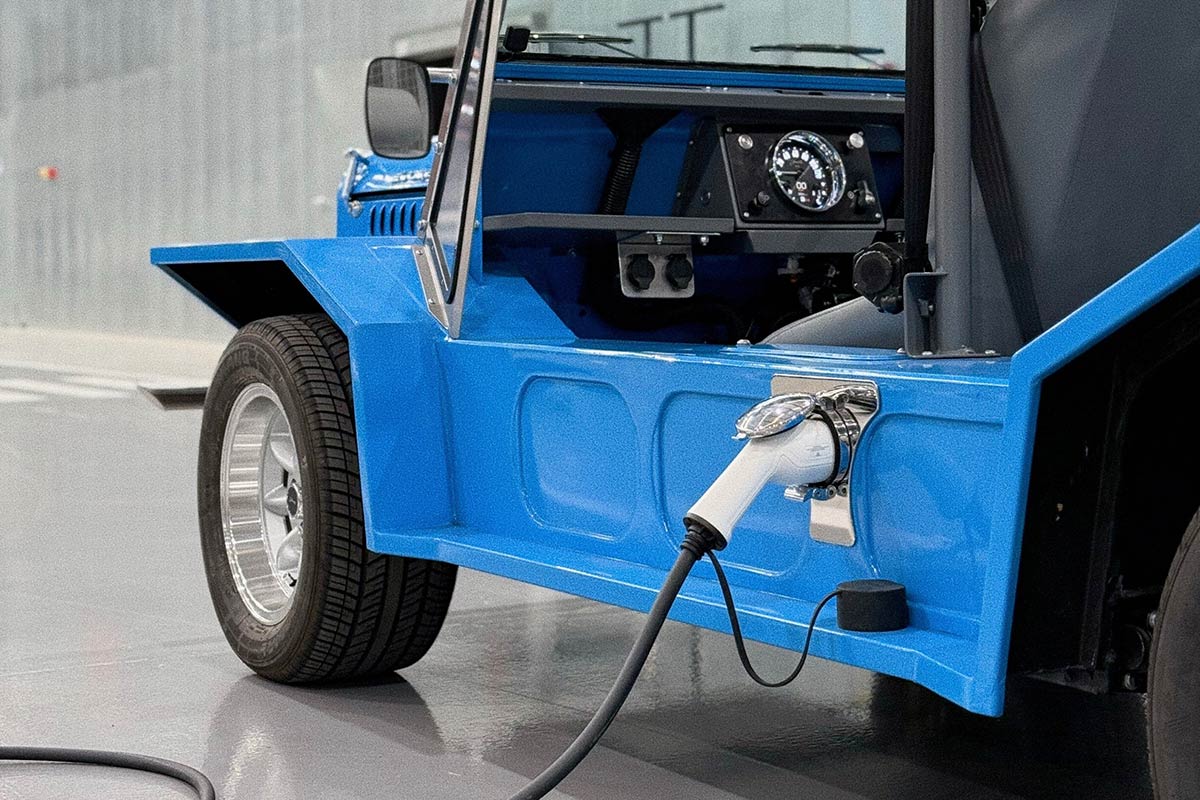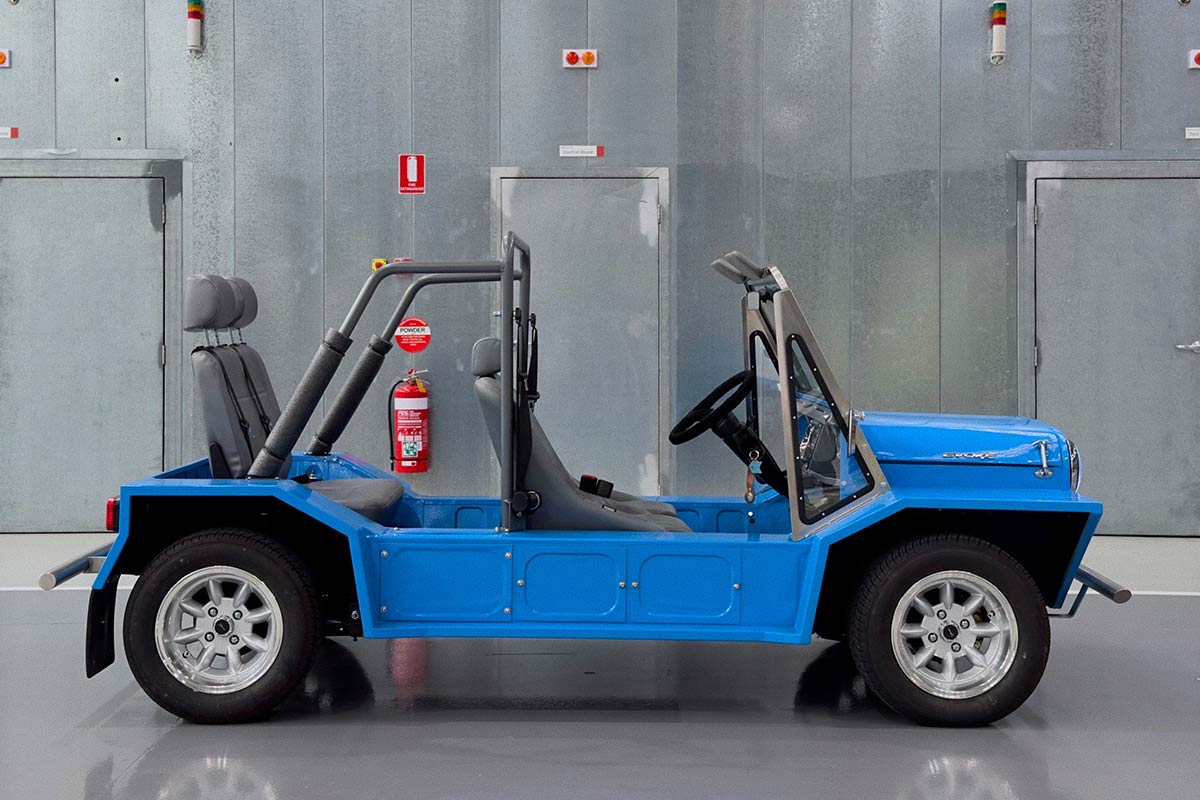
“It's basically a polished bathtub with the performance of a hot hatch, which makes it maybe the most ridiculous car we’ve ever built and also.... one of the best.”
These are the words of Dave Budge, co-founder of electric car conversion company Jaunt Motors .
It’s hard not to get excited about a stainless steel Mini Moke hurtling down the highway at a rate of knots, perhaps even more so when it’s powered by electrons.
For the nostalgic amongst us, the Mini Moke harks back to simpler times of lazy summer beach days and holiday bush-bashing peppered with a side of devil-may-care.
Now, the mass-produced British military vehicle of the 1960-1980s is being yanked into the 21st century by Melbourne’s Jaunt Motors, which converts old model cars like Land Rovers and Mini Mokes to electric drivetrains.
“Five years ago, six years ago, it was like: here's what we're going to do; but now we can actually say here's what we've done, which is nice,” says Budge, speaking with Open Road.
“From an EV perspective, it actually ticks a lot of boxes,” Budge explains. “Even though it's this tiny, weird little car without features ... it's got vehicle-to-load, it's got ... all our tech.”
In a video shared on social channels, Budge describes the sheer joy of driving one of the Mokes the company has converted at top speed.
The Moke in question now sports a 72kW motor powered by a 19kWh battery pack. Weighing in at around 700kg, the conversion setup delivers enough torque to make it “equivalent to a Tesla Model 3 Performance”.
The battery provides around 160-180km of driving range before it needs a recharge. The only downside perhaps is that only AC charging is on offer, meaning some serious chillout time – okay, a couple of hours – between beach jaunts.
After a recharge, though, the electric Moke can reportedly sprint from zero to a hundred in seven seconds: not that you’d want to. It’s not quite as quick as Tesla’s electric sedan but certainly appears adrenaline-wrenching enough for something that is inches off the ground with no head protection. 80km/hr tops and things gets crazy enough.
Two-thirds of the battery are under the bonnet and the other third is in the rear. Structural elements such as the side screens have been replaced with more sturdy materials - “because one of the things of course is once you make everything silent, you can hear everything,” says Budge. “You want to decrease rattles, and of course wind noise, where possible."
With wide tyres for traction that allow the electric Moke better performance and add to a solid, planted driving experience, Budge says it is “enormous fun on the road.”



— Dave Budge
Despite its 'throw caution to the wind' vibes, the electric Moke by Jaunt does in fact comply with and go beyond Victorian design standards. This includes inertia seats that allow for over-the-shoulder seat belts in the back, and stronger roll bars.
“Even though you're choosing a Moke, you still want the safest car that you can possibly have,” says Budge.
“Although we don't have to, we're going to reengineer the seat belt structure to be safe for, you know, 2025 standard.”
Without these additions, “The EV conversion like-for-like is lighter, says Budge. “But then we put in bigger roll bars and more seats... and those things add to it.” Additions like these also mean the vehicle is registerable in all states.
Beyond the Moke, Jaunt Motors is steadily expanding its electric conversion portfolio. The company's most consistent demand remains with its electric Land Rover builds, which Budge says attract buyers who would otherwise be eyeing brand-new luxury SUVs.
“For our Land Rover customers... those customers are sometimes cross-shopping from a brand new Range Rover,” says Budge. “You can spend more and stuff, but by the time you maybe repaint it and do the interior, you're equivalent to the price of a new Defender or Range Rover. But you get something that you think looks cooler and is a full EV.”
The workshop is also working on a number of other classic conversions, including an upcoming Kombi and another that’s bound to turn heads among purists:
“We have a Porsche 911 in the workshop that we're working on now,” Budge says. “Hopefully we’ll do some test drives and things for people with that because it will be very fun.”
They’re also planning a bold move into American muscle territory with a high-profile rear-wheel-drive build.
“The other fun one will be a 1958 Corvette that we're doing as well,” he reveals. “That'll be the third example of our kind of rear-wheel drive platform, which... gets classic Australian automotive world excited — or angry, whatever the case may be.”
And while the idea of a AU$165,000 beach buggy might seem bonkers, that’s sort of the point.
In a world of cookie-cutter crossovers and touchscreen sameness, Jaunt’s electric Moke — and the growing stable of retrofitted classics — is a reminder that cars can still be fun, functional, and a bit ridiculous. Or as Budge puts it: “Sometimes expensive things are worse… but weirdly, that’s what we build.”